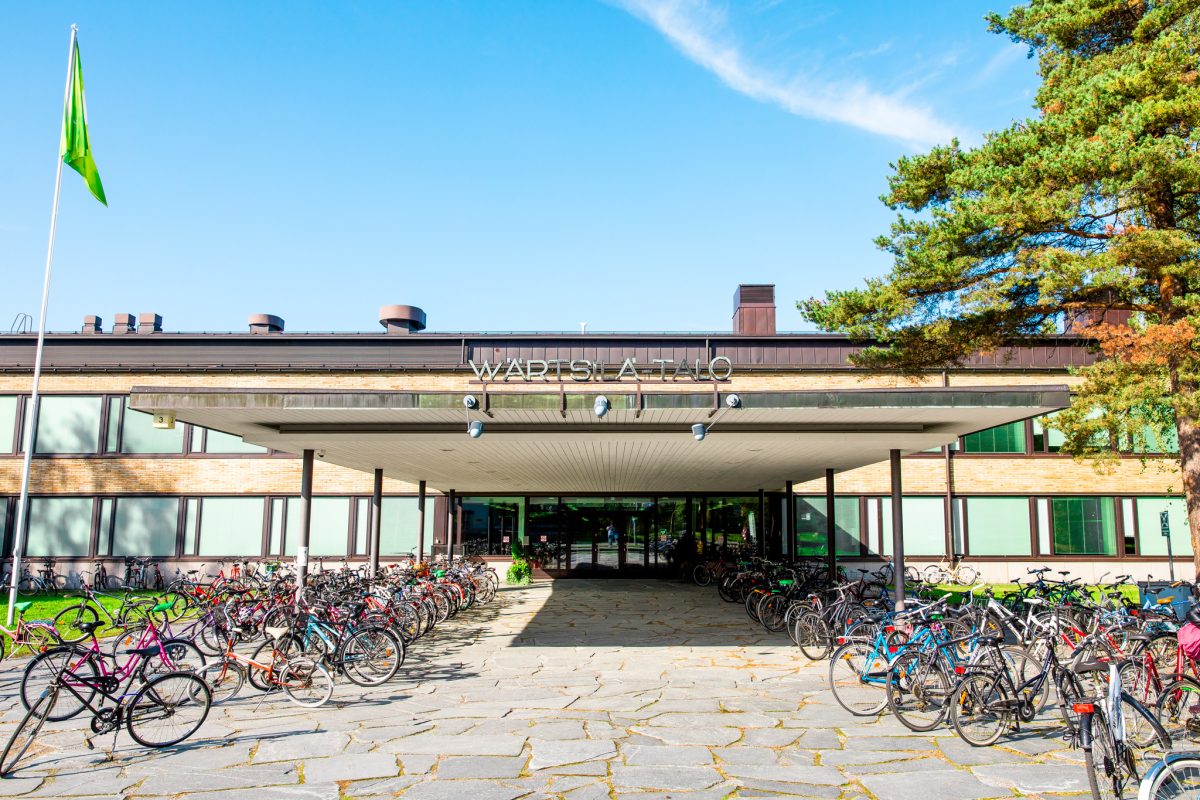Karelia University of Applied Sciences (Karelia UAS) does not have a separate quality system, but the different elements of quality management are incorporated into the enterprise resource management and Intranet system of the institution. Thus, quality management is intended to be a natural part of the normal, daily activities of Karelia UAS.
The quality management of Karelia UAS is based on the Deming Cycle for continuous improvement (Plan, Do, Check, Act). In this model, planning, acting, evaluating and developing are repeated in cycles, aiming at ensuring continuous learning and development within the organisation. Furthermore, other key elements of quality management at Karelia UAS include external steering of operations, the strategic base of the UAS, and the management system.
This Quality Handbook describes the main operations of Karelia UAS. The contents of this handbook are organised according to the above-mentioned elements on quality management.
Table of contents
1 Quality policy at Karelia University of Applied Sciences
2 External steering
3 Strategic base
4 Management system
5 Planning of operations
6 Operational processes
7 Evaluation of operations
8 Development of operations
Appendices
- Strategy of Karelia University of Applied Sciences
- Impact matrix of Karelia University of Applied Sciences
1 Quality policy at Karelia University of Applied Sciences
The quality policy of Karelia UAS is based on the Deming Cycle for continuous improvement (Plan, Do, Check, Act) and on the different elements of quality management being incorporated into the enterprise resource management and Intranet system of Karelia UAS. The key aim of quality management at Karelia UAS is to run smooth operations in order to achieve the objectives defined in the strategy. The implementation of quality work is based on the principle of subsidiarity, which means that the aim is to solve any possible problems as close to the place of actual action as possible. Collaboration and participation of each member of Karelia UAS community in quality work in one’s own area of responsibility are the foundation for the quality of operations.
Aims of quality management
- to run smooth and appropriate operations in order to achieve the objectives defined in the strategy
- to identify the needs of students and service users and fulfil any promises made
- continuous development of operations, and
- to make the development work visible in all activities including the work of each employee.
This Quality Handbook describes the aims of quality management at Karelia UAS as well as the key elements of enterprise resource planning (ERP) and the quality system of Karelia UAS. The Quality Team of Karelia UAS is responsible for updating the Quality Handbook and it is approved by the President. Links to other documents and supplementary materials are also included in this Quality Handbook.
Basic principles of quality management
Karelia UAS does not have a separate quality system, but the different elements of quality management are incorporated into the enterprise resource management and Intranet system of Karelia UAS (Karelia Intranet). Thus, quality management is intended to be a natural part of the normal, daily activities of Karelia UAS. The structure of Karelia Intranet is based on the most essential elements of quality management (Figure 1).
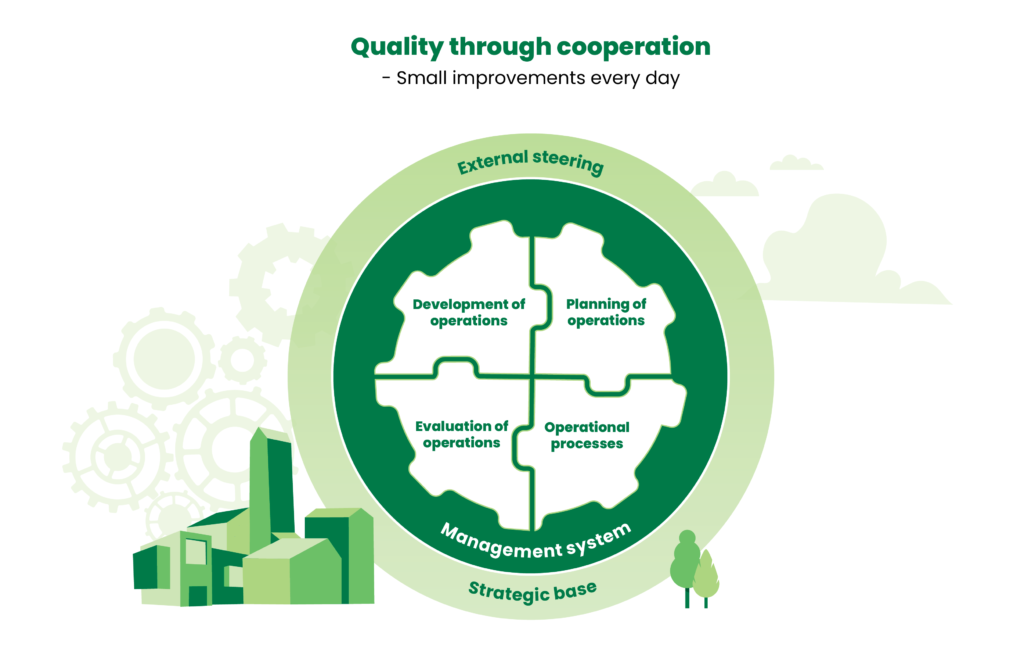
Figure 1. Elements of quality management at Karelia UAS
Quality management at Karelia UAS follows the PDCA Cycle (Plan, Do, Check, Act) by W. E. Deming, which is based on the idea of planning, acting, evaluating and developing being repeated in cycles, aiming at ensuring continuous learning and development within the organisation. Furthermore, other key elements of quality management at Karelia UAS include external steering of operations, the strategy of the UAS, and the management system.
The quality management of service and development environments of Karelia UAS is based on the requirements of the field in question. The accredited testing operations of Karelia UAS construction laboratory comply with the ISO-17025 standard.
The enterprise resource planning (ERP) process of Karelia UAS is implemented at three levels:
- between the Ministry of Education and Culture and Karelia UAS
- between the management and the different units of Karelia UAS, and
- as an internal ERP in each unit
The ERP process at Karelia UAS includes the following, regularly implemented measures:
Strategy work
- the strategy is drawn up as a participatory process
- evaluation of the implementation of the strategy and possible updates during the strategy period
- annual strategy planning days organised for the entire staff
ERP between Karelia UAS and the Ministry of Education and Culture
- performance agreement negotiations with the Ministry of Education and Culture every four years (OKM/TASO)
- annual reports
- feedback from the Ministry and regional seminars during the agreement period
Annual ERP at Karelia UAS
- preparation of an internal performance agreement (Karelia/TASO) and monitoring of the implementation three times a year (together with operational and financial reviews)
- annual self-evaluation and management review
- monthly monitoring of operations and financial results in the UAS Board and in the Management Team, and at the meetings of the Heads of Education and at staff meetings
- annual budgeting and interim reports quarterly
- updating the personnel plan annually
- annual development discussions
The implementation of quality work at Karelia UAS is based on the principle of subsidiarity, which means that the aim is to solve any possible problems as close to the place of actual action as possible. For example, teachers responsible for single study units and employees in charge of certain teams take the responsibility for their own study units and duties as well as for the development of their own work. Heads of Education are in charge of the development of curricula and implementation of education and the Education Development Team coordinates the development measures of education at the entire UAS.
Following the principles of Open Science and Research, Karelia UAS has an open communication culture that helps the institution to make all the knowledge and competence created available for all. The forms of open communication include publication of research materials and popularisation of the results, and open research methods. The open communication culture is used to promote the social impact of research and development activities and to enable new forms of cooperation and innovations.
Responsibilities in quality management
The President of Karelia UAS is responsible for the quality of UAS activities and for the development of quality. However, each employee and student is responsible for the quality of his/her own work as well as for the development of this quality, and for the participation in the development of his/her own work or study community.
A Quality Team appointed by the President is one of Karelia UAS development teams, which is responsible for organising and developing quality management and maintaining quality competence, and for quality-related communication. The Quality Team also has a student member nominated by the Student Union POKA. Responsibilities related to quality management procedures are described in more detail at the end of this handbook.
2 External steering
The external steering of Karelia UAS can be divided into international, national and regional steering. The central external factors affecting the operations of Karelia UAS are the building of the European Higher Education Area (EHEA), national policies of higher education, the needs of the labour market in the region, and interest group relations and partnerships.
Besides the changes in the national educational policy, the international policy of higher education has more and more effect on the operations of Finnish institutions of higher education and on the development of their quality assurance systems. The European higher education policy is strongly characterised by the creation of a common European Higher Education Area (EHEA). Common principles for quality management in Europe have been described in the document Standards and Guidelines for Quality Assurance in the European Higher Education Area (ESG) from year 2015. The aim of the European Research Area (ERA) is, for example, to promote the free movement and work of researchers in the EU, the establishment and operation of common research infrastructures, and a better use of publicly funded research. Finnish higher education institutions are committed to operating in accordance with the principles of ERA and to promoting the achievement of the objectives.
The national quality assurance of Finnish higher education consists of three parts: national higher education policy steering, higher education institutions’ own quality management, and national evaluation (Figure 2). The Ministry of Education and Culture is responsible for steering the national higher education policy. The steering is based on the legislation, operating licenses for universities of applied sciences, and on the performance agreement procedure between the Ministry and universities of applied sciences.
According to the law, all higher education institutions are self-governing and the institutions are themselves responsible for organising high-quality education and developing the education. Each higher education institution is entitled to build up their own quality management system that best suits its own purposes. Higher education institutions are responsible for participating in external quality management system audits every six years. The results of external audits are public.
The Finnish Education Evaluation Centre (FINEEC) is an agency responsible for the external evaluation of education in Finland. One of the committees in the centre is the Higher Education Evaluation Committee, which is responsible for deciding on issues related to evaluation in higher education and for approving the results of external audits. The Finnish auditing model focusing on developmental evaluation has been drawn up based on European quality management principles.
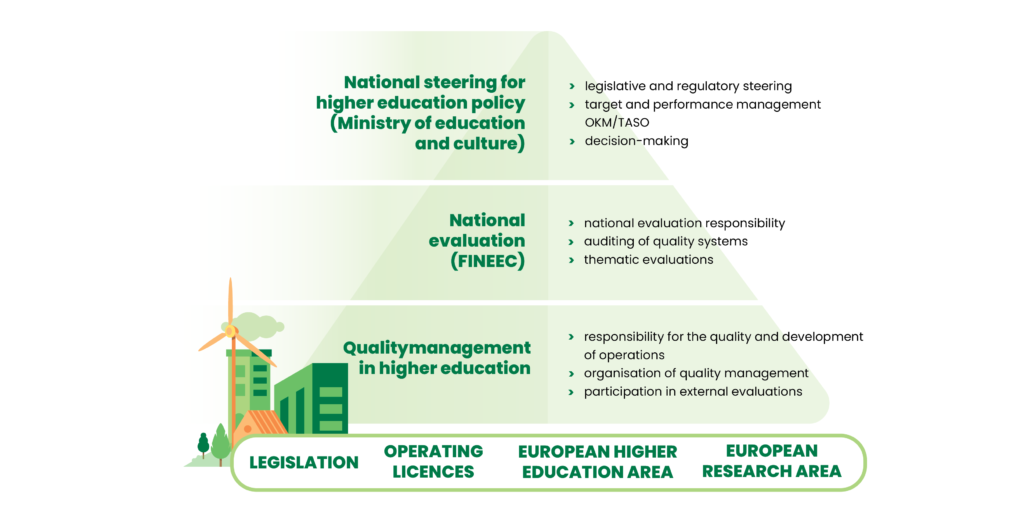
Figure 2. National quality management responsibilities for Finnish higher education institutions
3 Strategic base
The strategy of Karelia UAS is the most important document steering the operations and choices of the UAS. The current strategy Karelia 2030 has been compiled for years 2020-2030. The strategy is drawn up as a participatory process together with the staff, students and key cooperation partners. The strategic policies of Karelia UAS are summarised in the following figure (Figure 3).
Figure 3. Strategic choices for Karelia UAS according to Karelia 2030 strategy
The strategy of Karelia UAS defines the desired state for the institution. The strategy guides the activities of the staff, decision-making, and internal and external cooperation. The policies defined in the strategy are based on national guidelines and requirements for higher education, on the needs and requirements of the labour market and the development of work, and on the development needs of the City of Joensuu and North Karelia.
The strategy is implemented and monitored using the Karelia/TASO agreement, the management review, and target and development discussions. A mid-term evaluation of the strategy will also be carried out, and based on this evaluation the priorities for the remaining strategy period will be selected. A final review of the strategy will be carried out at the end of the strategy period.
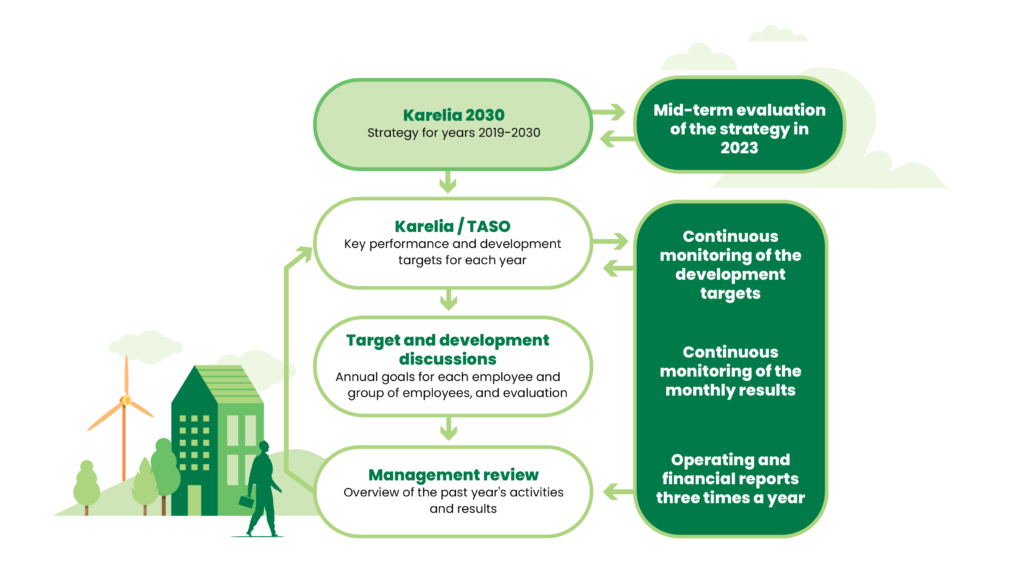
Figure 4. Implementation and monitoring of Karelia 2030 strategy
4 Management system
Karelia UAS is a multidisciplinary university of applied sciences, the statutory functions of which include education, research, development and innovation activities, and service business. Karelia UAS is a limited company owned by the City of Joensuu. The highest authority lies in the Annual General Meeting (AGM). The AGM elects the Board for the limited company, which is responsible for the administration and organising of operations. The company has a CEO appointed by the Board, who is also the President of Karelia UAS.
Karelia UAS operations are regulated by the following rules (approver in brackets):
- Administrative policy of Karelia UAS (Company Board of Karelia University of Applied Sciences Ltd)
- Degree regulations (Company Board of Karelia University of Applied Sciences Ltd)
- Operating rules (President)
The administrative policy of Karelia UAS defines the operations and administration of the company. Degree regulations are intended to clarify the juridical specifications related to UAS studies. Operating rules determine the internal organisation and management of the UAS according to the guidelines defined by the internal administrative policy.
Decision-making at Karelia UAS is based on the principle of presentation. Presenters named in the operating rules are responsible for the preparation of matters to be handled by the Board of Karelia UAS Ltd. The Management Team handles matters and decisions presented by the Board. Besides the President, officials are entitled to make position holder decisions, since the President has given the power of decision to certain officials, as defined in the operating rules.
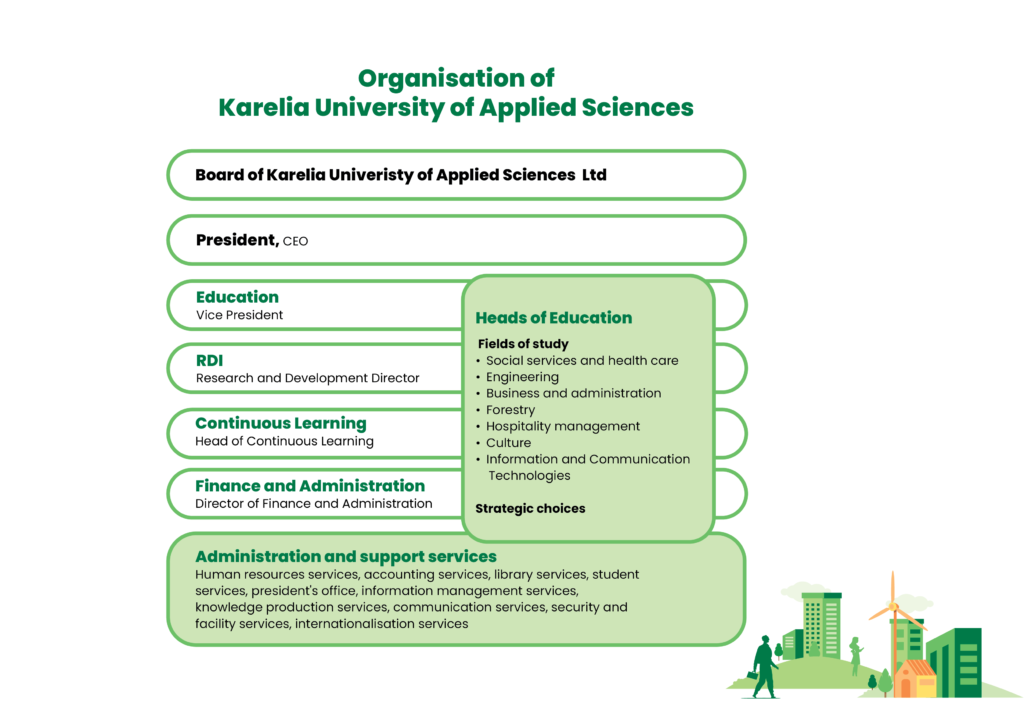
Figure 5. Organisation of Karelia University of Applied Sciences
5 Planning of operations
The key documents in the strategic enterprise resource planning at Karelia UAS include the strategy, the performance agreement signed with the Ministry of Education and Culture (OKM/TASO) and annual, internal performance agreement of Karelia UAS (Karelia/TASO).
- The Karelia 2030 strategy is the most important document steering the operations and choices of Karelia UAS.
- The performance agreement signed with the Ministry of Education and Culture (OKM/TASO)sets targets for universities of applied sciences for four-year periods. The agreement defines the strategic choices, profile and the areas of strength, the measures supporting the strategy of the UAS, the aims regarding the number of degrees, and financing.
- The implementation of the strategy is monitored with Karelia/TASO agreements, which are regularly updated and prepared for the following two-year period. The Karelia/TASO agreement defines performance targets for the UAS and its different units as well as development projects supporting the implementation of Karelia UAS strategy and people responsible for these projects.
In addition, Karelia UAS has several recurring planning activities related to different operations in practice.
- Education-related plans include e.g. curricula and implementation plans, schedules, teachers’ work time plans, and the development plan for continuous learning.
- RDI activities are steered by the RDI plan and project plans for each project.
- Partnership agreements and action plans for each partnership steer the collaboration with key partners.
- Handling of HR issues is based on the strategic human resources plan of Karelia UAS and an annually updated personnel plan.
- Key documents steering the finances are the budget and the investment plan.
6 Operational processes
Process descriptions are being used to describe the different policies applied within an organisation as well as the related responsibilities. The processes are based on the strategy, rules and regulations, and the key operations for students and service users. The development of organisational processes is related to the overall planning and development of other UAS activities. The development of processes aims at improving efficiency, quality of operations, fluency and the level of services, managing problematic situations, and ensuring an efficient use of resources.
Karelia UAS processes are divided into core activity, strategic management and steering processes (Figure 6). The process diagram and the related concepts are based on the recommendations by the Advisory Committee on Information Management in Public Administration (JUHTA), which have been applied at Karelia UAS.
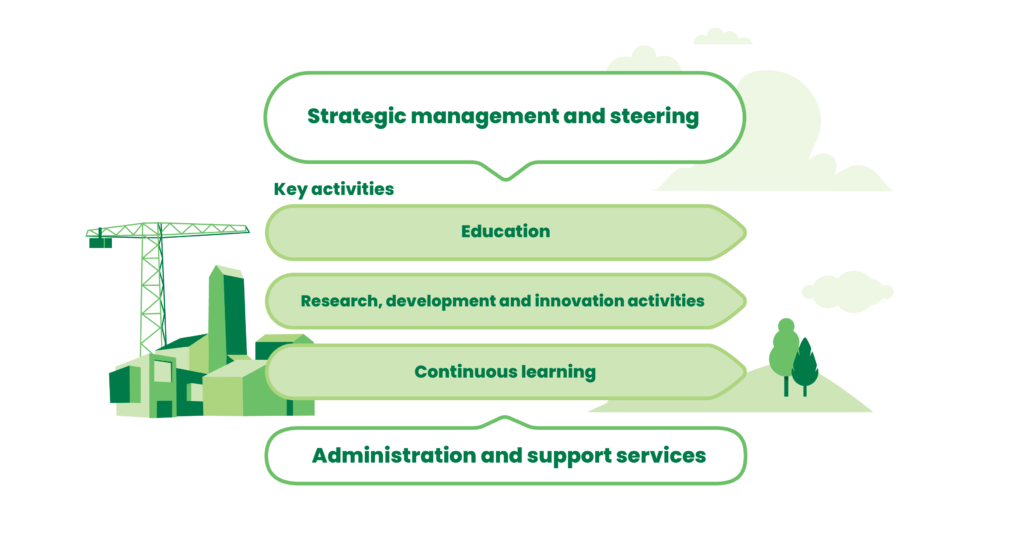
Figure 6. Karelia UAS process map
Process descriptions have been drawn up for the core activities and for the strategic management and steering processes. If needed, the descriptions have been specified with additional operating and working instructions. Support services descriptions have not been listed as such but they have been integrated into process descriptions. Separate instructions have been compiled for personnel and financial issues.
The processes are primarily described from the customer point of view in order to ensure smooth activities and services. Simplicity has been emphasised when drawing up the descriptions. Hence, details of each operation are not listed, but the descriptions focus rather on operations that are essential for UAS activities. The process descriptions for core activities and strategic management and steering have been illustrated on Karelia Intranet in their own contexts.
Strategic management and steering
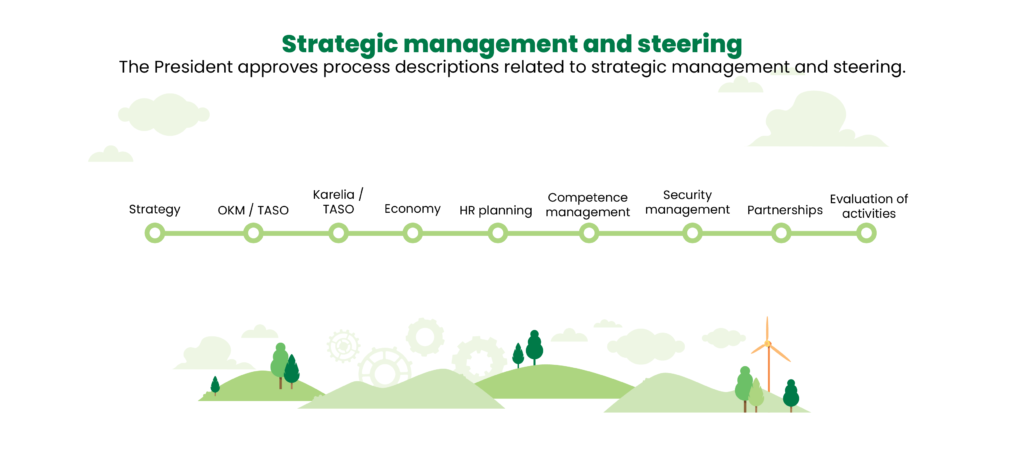
Education
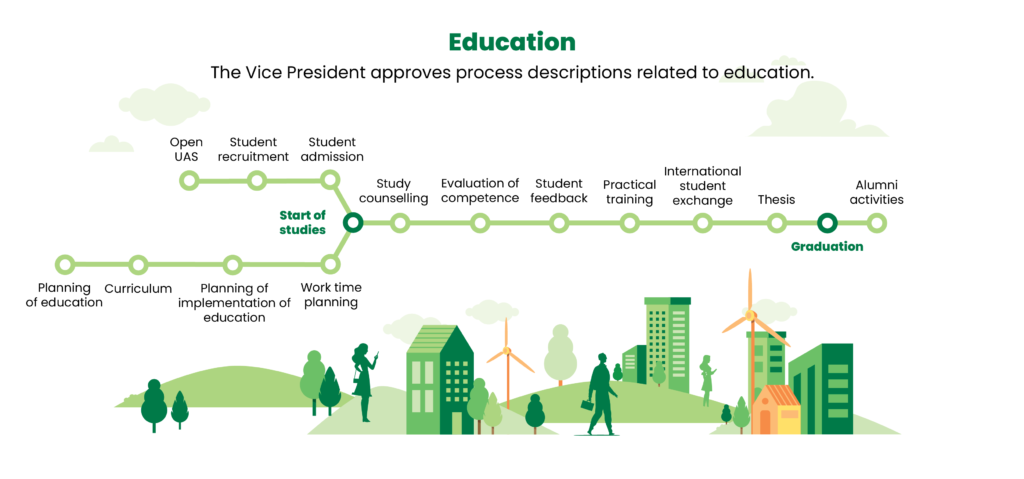
Research, development and innovation activities
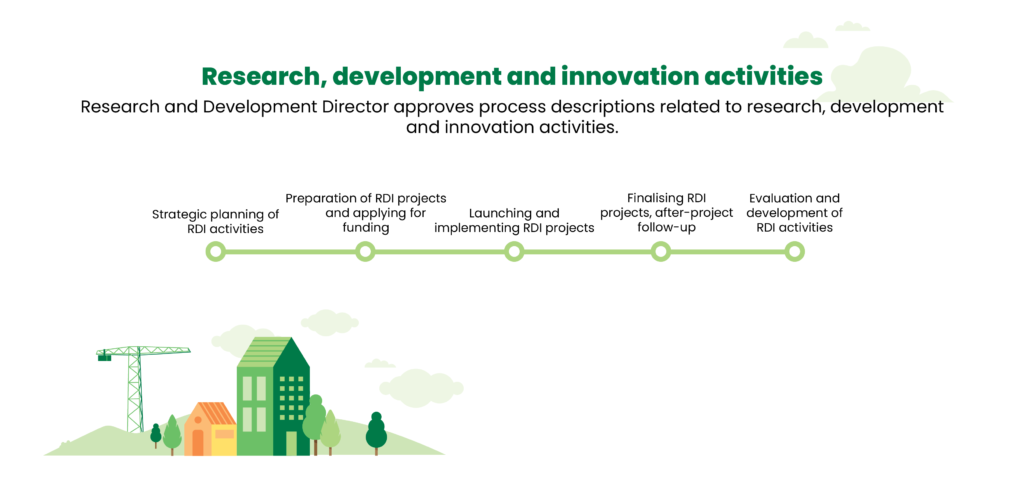
Continuous learning

7 Evaluation of operations
The evaluation of the operations of Karelia UAS consists of external evaluations, feedback collected with feedback systems or by other means, and internal evaluations.
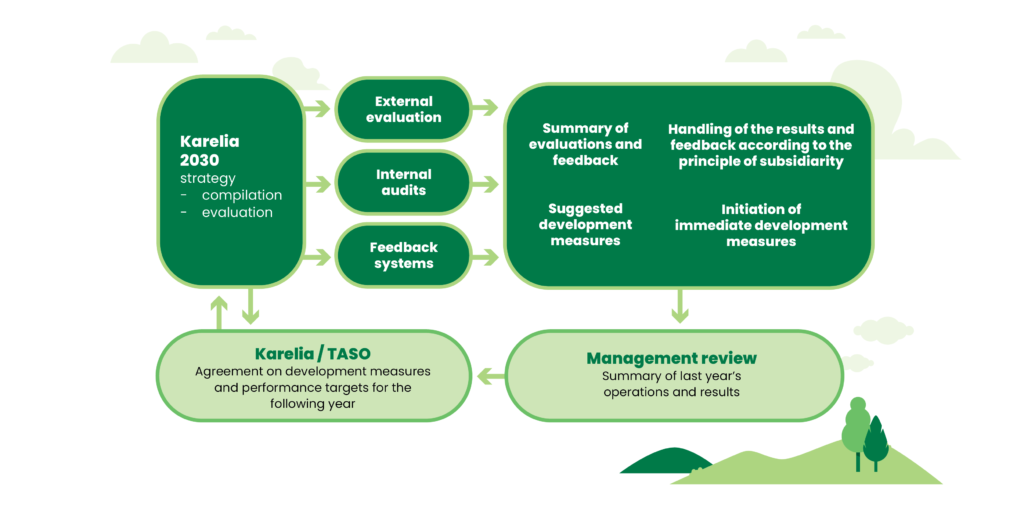
Figure 7. Handling and use of feedback information in development work
External audits
The Finnish Education Evaluation Centre (KARVI) is responsible for the national audit activities of higher education institutions. The quality management of Karelia UAS has been audited twice, in 2011 and in 2017. The following external quality audit of Karelia UAS takes place in 2023. The UAS and its different units participate actively in field-specific or thematic evaluations.
The themes of the year 2023 quality audit are as follows:
- HEI creates competence
- HEI promotes impact and renewal
- HEI enhances quality and well-being
- HEI as a learning organisation
In international educational cooperation, the quality management and the related external accreditation of joint degree education and other co-education will be carried out in accordance with European standards.
Feedback systems
The feedback systems used at Karelia UAS include a student feedback system, a working life feedback system, and a staff feedback system. The feedback is collected using electronic feedback systems; student feedback is collected using Karelia UAS’ own student feedback system (Karelia/OPALA), course feedback system, the national graduand feedback questionnaire AVOP, and a follow-up career survey conducted five years after the graduation. Student feedback has been systematically collected at Karelia UAS since the academic year 1999-2000, staff feedback (HEPALA) since 2001, and working life feedback since 2005. In RDI activities, project-specific feedback is collected as part of the implementation of the project, and a broader RDI and service business feedback survey is conducted annually.
The results of the feedback surveys are analysed, and a summary and analysis of the feedback is discussed with the respondents. Development measures to be initiated will be decided based on the results. The feedback surveys are handled, and the development measures are implemented either based on the principle of subsidiarity, which means that any possible problems are solved as close to the place of actual action as possible, or with the entire staff of Karelia UAS. Feedback data is interpreted by the management review annually.
In addition to system-based feedback, immediate feedback plays an important role in the development of activities. Immediate feedback is discussed in staff meetings, in the meetings of Heads of Education, and, if necessary, by the Management Team of Karelia UAS.
Besides the previously mentioned feedback systems, Karelia UAS collects feedback of its various activities on a regular basis. The collection and processing of this feedback is described in the instructions for each activity.
Student feedback
Karelia UAS uses systematic feedback systems when gathering feedback from students throughout their entire time of studies. The feedback consists of study unit-specific feedback and OPALA feedback. Karelia/OPALA feedback is common feedback collected from all degree students at Karelia UAS once a year. Graduating students answer to the national AVOP feedback questionnaire for graduating students at universities of applied sciences. In addition, students have the opportunity to give open feedback on Pakki Student Intra and direct feedback to any person responsible for each operation.
Working life feedback
The purpose of working life feedback surveys is to identify and develop the connection between Karelia UAS and its partners in practical trainings, theses, and in RDI and service business activities.
Staff feedback (HEPALA)
Feedback from the staff of Karelia UAS is collected annually in form of an employee satisfaction survey.
Internal evaluations
The management review is an annual, internal evaluation method. In addition, mid-term evaluation regarding the implementation of Karelia UAS strategy is carried out every few years as well as an internal audit of activities and the quality assurance system.
Mid-term evaluation of the strategy
Continuous monitoring of the strategy and the objectives of Karelia/TASO is carried out in operational and financial reviews three times a year. An extensive mid-term evaluation of the implementation of the strategy is carried out in the middle of the strategy period, resulting in a possible change of priorities for the rest of the strategy period.
Internal audits
Internal audits are annually carried out at Karelia UAS in cooperation with partner organisations and representatives of working life. The aims of internal audits are as follows:
- to receive feedback of the functionality and development needs of the Karelia UAS quality system
- to strengthen the staff and students’ competence in quality work
- to support the implementation of quality work, and
- to prepare for the external audit of the quality system.
Audits conducted by representatives of working life
In academic year 2022-2023, Karelia UAS pilots audits conducted by representatives of working life in cooperation with the North Karelia Chamber of Commerce. The aim of the audit is to ensure that the education meets the needs of working life and to strengthen the cooperation between Karelia UAS education and the world of work.
Management review and annual report
Management review is an annual method of evaluation at Karelia UAS, the aim of which is to provide a concise overview of the past year’s activities and results and to assess whether the objectives defined for the year have been obtained.
The management review is compiled every year in April-May, after the past year’s results have been gathered. Besides the past year’s result, the management review also evaluates this year’s results as far as they are available.
A concise report is compiled based on the management review. The results of the review and any resulting development activities are dealt with when outlining the following year’s action plan (Karelia/TASO).
An annual report is compiled at Karelia UAS each year. The annual report includes a review of the previous year’s activities and results.
8 Development of operations
The development needs of Karelia UAS can be divided into needs concerning the entire UAS, unit-specific needs, and needs concerning a single employee or a group of employees. Long-term development of the entire UAS is based on the performance agreement signed with the Ministry of Education and Culture, strategic choices, areas of development selected based on received feedback, regular monitoring and evaluation of the implementation of development practices, and annual management review and internal audit.
The main development practices for the entire UAS as well as the related areas of responsibility are written down on the annual internal Karelia/TASO agreement. Besides the development of all core activities of the UAS, the agreement includes performance targets for both the entire UAS and each field of education. Appointed employees responsible for the key development targets are in charge of the planning and implementation of the development measures and ensure the availability of the necessary resources for the implementation. The implementation of the development measures is monitored three times a year in connection with the joint operational and financial reviews of the Management Team and with employees responsible for the Karelia/TASO agreement, and the results for the entire year are assessed by the management review.
Karelia UAS development teams have a key role in the implementation of development measures related to core activities. The teams draw up annual action plans, which are reviewed by the Management Team. Many of the strategic development projects will continue for several years. Implementation of the key development measures is assessed by the Management Team and the annual management review.
The Karelia/TASO agreement creates a foundation for the development of Karelia UAS. In addition, based on the principle of subsidiarity, the regularly monitored indicators and the feedback received are discussed in staff meetings.
The joint planning days of Karelia UAS Management Team, supervisors and team managers are carried out twice a year. The purpose of the days is to ensure that the set goals are met, to have a common view of the current situation, and to plan a time span of approximately 1-2 years.
Activities and competences are evaluated at an individual level by annual development discussions, and aims for the development of each employee are set according to the PDCA cycle. Development discussions are conducted during the same period of time in the entire organisation according to common guidelines. After individual discussions, a summary of the discussions will be handled as instructed by the supervisor.
In accordance with the principle of continuous improvement, various targeted feedback questionnaires and surveys and subsequent development measures are carried out as necessary.
Quality management responsibilities
| ADMINISTRATOR / ADMINISTRATING UNIT | AREA OF RESPONSIBILITY IN QUALITY MANAGEMENT |
| President Management Team | The results of UAS operations, quality and the development of quality. |
| Quality Team Director of Administration and Finance Knowledge Production Specialist | The organising and development of the quality system, maintenance of quality competence and communication relating to quality management. |
| Chairs of Development Teams / Development Teams | the development of quality and quality management in one’s own area of responsibilitythe coordination of compiling and evaluating common process descriptions/instructionsthe handling of the feedback on quality, compiling a summary of the received feedback and communicating about issues regarding feedbackcoordinating development measures regarding the entire UAS |
| Supervisors | the results and quality of operations and the implementation of activities presumed by the quality system in one’s own unit/teamthe handling of the feedback on quality, compiling a summary on the received feedback and communicating about issues regarding feedbackinitiating development measuresthe development of quality awareness among students and staffinteractive partnership and interest group collaboration |
| People in charge of processes/instructions | Describing the process/drawing up instructions and keeping them up to date on Karelia Intranet and Pakki Student Portal and for the development of activities in one’s own areas of responsibility. |
| Approvers of processes | Each of the core activities at Karelia UAS (i.e. strategic management, education, RDI activities, and service business) has a responsible owner who accepts the process descriptions/instructions of their respective areas of responsibility. |
| Student Union POKA | Participation in the development of the UAS community and development of students’ awareness of quality. Appointing representatives for the decision-making bodies and development teams, field-specific meetings and other teams. |
| Karelia UAS staff and students | the quality of one’s own work and the development of qualityone’s own learning and the development of competencethe giving and receiving of feedbackparticipating in the development of one’s own work/study community |
Concepts of quality management and enterprise resource planning
| Auditing | Auditing is an independent external activity, the aim of which is to determine whether the quality assurance system meets the set objectives and whether it is effective and suitable for its purpose. Finnish higher education institutions are required to attend an external auditing of their quality assurance systems at regular intervals. The Finnish Education Evaluation Centre (FINEEC)is responsible for the implementation of auditing. |
| Accreditation | Accreditation means that an educational institution or a degree programme is awarded with a specific quality label or authorisation on the basis of an evaluation process. Approved accreditation is a public recognition and evidence that the educational organisation or degree programme has met the criteria defined for accreditation. |
| Quality | As seen from the perspective of universities of applied sciences, the term quality means appropriate activities taken to achieve the objectives defined in the strategy. From students’/customers’ point of view, quality means that the UAS provides education and services, the quality of which corresponds to the set quality promises and service users’ expectations and needs. |
| Quality policy | The quality policy consists of the objectives and basic principles of the quality system and the division of responsibilities regarding quality management. |
| The Finnish Education Evaluation Centre(FINEEC) www.karvi.fi | FINEEC is an independent government agency responsible for the national evaluation of education. The aim of FINEEC is to implement evaluations related to education, education providers and higher education institutions. FINEEC includes a Higher Education Evaluation Committee, which decides on evaluation plans as well as planning and evaluation teams for higher education evaluations. The Committee also decides on the outcomes of the audits of the quality systems of higher education institutions. |
| Management review | Management review is an annually recurrent evaluation practice at Karelia UAS, the objective of which is to evaluate the activities of the UAS during the past year as well as results achieved in relation to the set objectives. |
| Quality management | The term quality management refers to the procedures that allow the UAS to ensure and develop the quality of education and other activities. |
| Quality system | A quality system is an entity consisting of quality management, responsibilities, procedures, processes and resources in the organisation. |
| Quality handbook | A quality handbook is a manual describing the structure and operations of the quality system. |
| Quality work | Quality work consists of quality management and development of the quality system. |
| OKM/TASO | OKM/TASO is a performance agreement signed between the higher education institution and the Ministry of Education and Culture, the aim of which is to specify the profile of the UAS, performance targets, priorities of development, and funding. |
| Feedback based on received feedback | Feedback based on received feedback refers to feedback that a person or a unit of a university of applied sciences has received and consequently answers to the received feedback by supplying their own interpretation of the feedback and any resulting development activities. |
| Karelia/TASO | Karelia UAS has an annual planning process for internal activities, which results in the Karelia/TASO agreement. The agreement defines the performance targets and development objectives for both the entire UAS and the different units. |
| Process/process description | The term process refers to a series of interrelated and repetitive activities that allow input to be converted into products or services. A process description is a verbal description of activities created to ease the understanding and guidance of activities. |
| Process map | A process map is a graphic description illustrating the most important processes of Karelia UAS and their interrelationships. |
| Approver of a process | An approver of processes is a responsible owner of an entire process of core activities at Karelia UAS. The approver accepts the processes and instructions in their respective areas of responsibility. |
| Process administrator | Process administrator is responsible for describing and developing the process and evaluating the functionality of it. |
| Working instructions | Working instructions are detailed instructions describing the key sections of a process including linking to the process description. |
| Annual timetable | An annual timetable is a diagram describing the timing of the annual ESR and quality management operations at Karelia UAS. |
| Key activity | Key activities are an entity essential for the entire organisation related to the serving of external customers. Karelia UAS’ key activities include education, RDI, and service business. |

